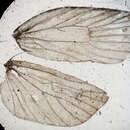Comprehensive Description
provided by Smithsonian Contributions to Zoology
Muna zostera
Alar expanse 21 mm.
Labial palpus straw color; second segment with ochraceous-tawny blotches on outer side; third segment ochraceous tawny on outer side and anteriorly. Antenna grayish fuscous above, buff ventrally. Head grayish buff. Thorax light cinnamon brown; tegula concolorous. Forewing ground color light cinnamon brown with violaceous tinge; at basal third two ill-defined fuscous spots, one in cell, the other on fold; from three-fifths of costa a broad straw-yellow transverse fascia extends outwardly to middle of wing, then curves inwardly to middle of dorsum; both inner and outer edges of this fascia irregularly marked with cinnamon-buff scales; between outer edge of fascia and termen, a series of five ill-defined, grayish-fuscous spots; cilia cinnamon brown mixed with a few straw color scales. Hind wing ocherous white shading to very pale cinnamon brown at apex. Legs ocherous white; foreleg tibia and tarsal segments suffused grayish fuscous on outer side. Abdomen sordid whitish with violaceous tinge.
Male genitalia slide USNM 24250. Harpe long and narrow, with a cluster of strong setae at base near costa; cucullus bluntly pointed; sacculus moderately sclerotized and with a very small point at its outer extremity. Gnathos an elongate, spined plate. Uncus hood shaped with median posterior point; posterior half of surface clothed with very fine, short setae. Vinculum rounded. Tegumen subrectangular, about as long as uncus. Anellus U-shaped. Transtilla a very narrow sclerotized band with a cluster of strong setae on each side. Aedeagus moderately slender, slightly curved; vesica unarmed.
HOLOTYPE.—USNM 73697.
TYPE-LOCALITY.—Chiloe Island, Dalcahue.
Described from the unique male holotype (10–12 Feb 1954, L. E. Peña).
The only species with which M. zostera can be compared is Coptotelia cyathopa (Meyrick) but M. zostera has a complete pale transverse band of forewing and the remaining ground color of M. zostera is darker than in C. cyathopa.
Altiura, new genus
TYPE-SPECIES.—Altiura maculata, new species (by monotypy and present designation). The gender of this generic name is feminine.
Labial palpus slightly ascending, nearly porrect; second segment slightly tufted anteriorly and posteriorly; third segment slender, acute, less than half the length of second. Tongue well developed; maxillary palpus filiform, free. Head very rough, scales on crown forming a tuft; ocellus absent. Antennae ciliated in male, simple in female; scape without pecten. Thorax smooth. Forewing smooth, costa arched, termen oblique, convex, 12 veins; 1b furcate; 1c strongly preserved; 2 well before 3; 3, 4, and 5 closely approximate; 7 and 8 stalked, 7 to costa; 9 much nearer to stalk of 7 and 8 than to 10; 11 from before middle; upper internal vein absent. Hind wing with 8 veins; 2 remote from 3; 3 and 4 connate or very short stalked; 4, 5, 6, and 7 about equidistant, subparallel. Hind tibia smooth. Abdominal terga not setose.
Male genitalia with uncus and gnathos.
Female genitalia with signum.
Altiura keys to the New Zealand Izatha Walker but differs from it by the absence of tufts of scales on the forewing, the slightly ascending labial palpus, and the smooth posterior tibia. In female genitalia there appears to be a close relationship to the South American genus Gonionota Zeller.
- bibliographic citation
- Clarke, J. F. Gates. 1978. "Neotropical Microlepidoptera, XXI : new genera and species of Oecophoridae from Chile." Smithsonian Contributions to Zoology. 1-80. https://doi.org/10.5479/si.00810282.273
Muna zostera: Brief Summary
provided by wikipedia EN
Muna zostera is a moth in the family Depressariidae, and the only species in the genus Muna. Both the genus and species were described by John Frederick Gates Clarke in 1978. It is found in Chile.
The wingspan is about 21 mm. The forewings are light cinnamon brown with a violaceous tinge. At the basal third, two ill-defined fuscous spots are found, one in the cell, the other on the fold. From three-fifths of the costa, a broad straw-yellow transverse fascia extends outwardly to the middle of the wing, then curves inwardly to the middle of the dorsum. Both inner and outer edges of this fascia are irregularly marked with cinnamon-buff scales. Between the outer edge of the fascia and the termen, a series of five ill-defined, grayish-fuscous spots is found. The hindwings are ocherous white shading to very pale cinnamon brown at the apex.
- license
- cc-by-sa-3.0
- copyright
- Wikipedia authors and editors

